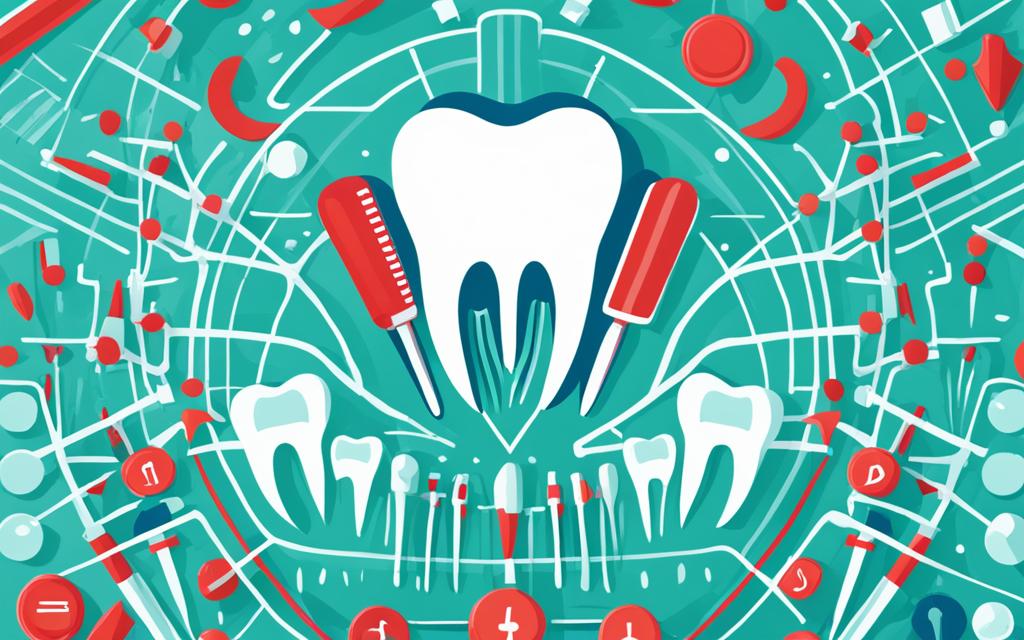Dental insurance can help you stay on top of your oral health and save money. But, it can be tricky to understand how it works. Let’s look into how dental network fees and insurance limits can affect your dental care.
Dental insurance often has limits on what it covers. While it usually includes preventive care, things like dentures or implants might not be fully covered1. Make sure to check your policy to see what’s covered and how much you’ll pay.
Insurance also has limits on how much it will pay in a year. This is called an annual maximum. If you spend more on dental care than this limit, you might have to pay the rest yourself1.
Choosing a dentist can also affect your costs. Dentists in your insurance network usually charge less because they’ve agreed on fees with your insurer. But, dentists outside your network might charge more, leaving you to pay the difference2.
Dental insurance rules can vary by state. Some states stop insurance companies from setting too low fees for services not covered by insurance1. This helps protect patients from unfair fees.
But, self-funded insurance plans and federal plans like ERISA don’t follow state rules. They have their own federal rules, which might be different from state laws1.
Key Takeaways:
- It’s key to know what your dental insurance covers to avoid surprises.
- Annual maximums set a limit on what insurance will pay in a year.
- Picking an in-network dentist can save you money on services2.
- State laws can help control fees for services not covered by insurance1.
- Self-funded and federal plans have their own rules and might not follow state laws1.
How Does Dental Insurance Work?
Dental insurance helps people and families cover dental care costs. It’s important to know how it works to make good choices for your oral health. We’ll look at dental insurance coverage, premiums, deductibles, coinsurance, and annual maximums.
When you join a dental insurance plan, you pay a monthly premium. This lets you use the plan’s benefits. These benefits include things like cleanings, exams, and X-rays, which keep your mouth healthy. You usually don’t pay for these out-of-pocket3.
For treatments like fillings, root canals, or dental implants, coverage varies. Dental plans might pay 50% to 80% of the cost, depending on the service34.
There are more things to think about with dental insurance, like deductibles, coinsurance, and annual maximums. A deductible is what you pay before the insurance starts covering costs. Coinsurance is the part you pay after the deductible. The annual maximum is the most the insurance will pay in a year or for your whole life3.
Dental insurance plans have networks of dentists who agree to charge certain rates. There are different types of plans, like PPO, HMO, and indemnity, each with its own rules for choosing dentists. PPO plans let you pick from many dentists but might cost more. HMO plans are cheaper but limit dentist choices. Indemnity plans let you see any dentist but cost more53.
Choosing an out-of-network dentist means thinking about quality, location, cost, and coverage rules. Some plans have waiting periods or require in-network visits to get full benefits4. Going out-of-network can mean paying more or all of the costs, depending on your plan5. Always check your plan’s details to make a smart choice.
What Does Dental Insurance Cover?
Dental insurance covers many services to keep your mouth healthy. This includes preventive, basic, and major procedures.
Preventive Services:
Preventive care is key to good oral health. It includes regular check-ups, cleanings, and X-rays. Most dental insurance covers these at 100%, helping you take care of your teeth without breaking the bank6.
Basic Services:
Basic services are for common dental work like fillings, simple tooth extractions, and root canals. Insurance usually pays about 80% for these. Remember, you might need to pay deductibles or co-pays first6.
Major Services:
Major services are for complex dental work like bridges, crowns, dentures, and implants. Insurance covers these, but at a lower rate, often 50%. Always check your policy for details on major services6.
Cosmetic Dentistry:
Cosmetic dentistry is not usually covered by insurance. This includes things like teeth whitening, bonding, and veneers. You’ll have to pay for these treatments yourself6.
It’s important to read your dental insurance policy well. Talk to your insurance company if you have questions. This way, you can plan your dental care better and make smart choices about your treatments.
Types of Dental Insurance Plans
There are many dental insurance plans to choose from, each fitting different needs and preferences. Knowing about these plans helps you pick the best one for you.
Preferred Provider Organizations (PPO) Plans
PPO plans let you pick from a network of dentists who agree to certain fees. If you see a dentist not in the network, you might pay more. PPO plans are great for their flexibility and lower costs within the network.
Dental Health Maintenance Organizations (DHMO) Plans
DHMO plans work on a capitation model. Dentists get paid a set amount for each patient. This makes them a budget-friendly choice, with no deductibles or waiting times.
Indemnity Plans
Indemnity plans, or traditional insurance, pay based on the procedures done. You can see any dentist you want and get paid for your expenses. This gives you freedom in choosing your dental care.
Direct Reimbursement (DR®) Plans
Direct Reimbursement plans pay based on what you spend, not the treatment. This lets you pick any dentist and get reimbursed for your costs. It gives you control over your dental care.
Point of Service Plans
Point of Service plans let managed care patients see out-of-network dentists but with less coverage. This is good for getting special treatments not in your network.
Discount or Referral Plans
Discount or referral plans have dentists who charge less, making dental care more affordable. You don’t need to file claims, making it a budget-friendly option.
Exclusive Provider Organizations (EPO) Plans
EPO plans make you use network dentists for coverage, limiting your choices. These plans are best for those who want to save money and accept fewer provider options.
Table or Schedule of Allowances Plans
These plans pay a set amount per treatment, with you paying the rest. Often linked with PPOs, they can limit dentist fees.
Knowing about dental insurance plans helps you find the right one for your dental needs and budget. Each plan has its pros and cons, so it’s key to look closely before deciding. The right plan ensures your dental health is a top priority without costing too much.
Source:7
What Does In-Network Mean?
Understanding in-network providers is key for those looking for affordable dental care. In-network means dentists who work with your dental insurance at set prices8.
Insurance companies prefer in-network offices because they’ve negotiated lower fees for you8. These dentists work with insurance to offer lower prices, making dental care cheaper for you9.
Visiting in-network dentists usually means paying less than going to those outside the network8. This deal helps both you and the dentist. You get affordable care, and dentists get fair pay for their work98.
In-network dentists meet high standards and join quality programs to give you the best care8. They also handle all the paperwork, making things easier for you8.
Choosing in-network dentists can save you a lot of money. You could save thousands on things like dental work9. For example, picking an in-network hospital can cut the cost of a stay by over $5,0009.
You can see dentists outside the network, but it might cost more. But, you can still use your insurance to help pay for it8. Still, sticking with in-network dentists is best to get the insurance discounts10.
The Importance of Out-of-Network Awareness
Knowing about in-network and out-of-network dental options is key for your oral health. In-network dentists get more patients thanks to free ads, which helps them earn more11. Out-of-network dentists can set their own prices and give personalized care11. But, going out-of-network might mean paying more and facing balance billing11.
Choosing an out-of-network dentist means you might pay more from your pocket since insurance covers less11. This could hurt your budget and affect your finances. Also, these dentists might not have deals with insurance companies, making it hard to get higher fees11.
But, out-of-network dentists often have flexible payment options11. They help with insurance claims, so you pay them first and then get reimbursed11. Many offer payment plans that are low-interest or even interest-free, making care more reachable12.
Choosing out-of-network care has its downsides, though. The higher costs might be too much for some patients11. These practices might also spend more time on billing, so they need to make it easier11.
Using out-of-network services can also use up your dental insurance fast, limiting future care11. Knowing what your insurance covers and the costs can help you decide wisely about your dental care.
In short, out-of-network care gives dentists more control and options, but think about the higher costs and how it affects your insurance and wallet. Making smart choices is key for your dental health and your budget.
Why Check Your Coverage Regularly?
It’s key to check your dental insurance often to make sure your needed procedures are covered. Not every dental procedure is covered, so checking with your insurance first is a must13. This way, you can dodge unexpected costs and financial shocks.
Looking over your plan helps you understand your costs, like deductibles and coinsurance13. Knowing this lets you plan your dental care better, avoiding any nasty surprises when paying.
Most dental plans cover preventive care, like check-ups and cleanings13. But, it’s vital to see what your plan covers and what it doesn’t. This helps you plan your dental visits better, using the preventive services your insurance offers.
Regularly checking your coverage and knowing its limits helps you make smart choices about your dental care. It’s key to be proactive and informed to get the most from your dental insurance13.
For more info on dental insurance and its terms, check out trusted sites like the Ameritas website13 or forums like Bogleheads14. These places offer great tips to help you understand dental insurance better and make smart choices about your coverage.
Enhancing Your Dental Insurance Knowledge
It’s key to know about your dental insurance to make smart choices about your dental care. Understanding your dental plan helps you deal with insurance’s complex parts. This ensures you get the coverage you should have.
One way to get better at dental insurance is by using your dental plan’s member account or app. These tools give you all the details you need, like what’s covered, how much you’ll pay, and your yearly limits. Knowing this helps you plan and budget for your dental care.
Another useful tool is the Ameritas Dental Cost Estimator. This online tool lets you see how much different dental procedures might cost. By using it, you can understand what you might pay and make better choices about your dental care.
Knowing about network providers is also important. Dental insurance plans have a list of dentists who work with them at lower costs. Going to these dentists can help you use your benefits better and save money. Always check if your dentist is in your insurance plan’s network before you go.
It’s important to keep up with your dental plan’s details. This ensures you know what’s covered and any changes that might have happened. Look out for updates to your plan’s rules and how much it pays. If you’re unsure about something, always ask your insurance company for help.
By learning more about dental insurance, you can handle its complex parts better. Stay informed and proactive to make the most of your dental benefits.
References
- 15 Dental benefit problems, such as delayed or denied payments, can impact the revenue for a dental office.
- 15 Many carriers have limited benefits for periodontal maintenance (CDT code D4910), leading to denials for some patients.
- 15 Claims for periodontal scaling and root planing (CDT codes D4341, D4342) are sometimes denied even for patients with abnormal pocket depths.
- 15 Core buildups, including any pins (CDT code D2950), are sometimes not reimbursed due to a lack of benefit coverage.
- 15 Pre-authorizations aim to determine a patient’s coverage, but claims may still be denied due to policy complexities.
- 15 Complaints are commonly raised about lost claims and lost radiographs causing processing delays and payment issues.
- 15 Bundling and downcoding by third-party payers can result in reduced benefits for patients.
- 15 The least expensive alternative treatment (LEAT) clause can restrict payment to the least costly treatment available.
- 15 Overpayment or refund requests may be received by dental practices from third-party payers, even years after the initial payment.
- 15 Some dental plans limit assignment of benefits to participating dentists only, causing challenges with collections.
- 15 Post-utilization reviews (retrospective claims audits) are conducted by payers without always informing the dentist being audited.
- 16 The “No Surprises Act” implemented in 2022 prevents unexpected medical bills but does not apply to dental care.
- 16 Good faith estimate regulations require uninsured patients to receive an estimate of expected costs within three days of request.
- 16 Disagreements over dental bills can be resolved through the Patient-Provider Dispute Resolution process.
- 17 The Affordable Care Act has expanded coverage and utilization of dental care services.
- 17 Dental offices must comply with the Payment Card Industry Data Security Standard to ensure credit card data security.
Conclusion
It’s key to know about dental network fees, insurance limits, and extra charges to manage your dental costs. Learn what your dental insurance covers to make smart choices about your dental care. This way, you can save money. Always check your plan details, find network providers, and confirm coverage to get the most from your benefits.
Seeing out-of-network dentists has its perks. They often use better supplies, charge less, and give you more personal care18. They might also offer payment plans or financing to make their services cheaper over time18. Plus, dental savings plans can cut costs on out-of-network dental care18. For more info, reach out to a local dental clinic like River District Smiles Dentistry18.
Studies show that how common dental insurance is affects what dentists get paid and the price ratio19. Also, changes in dental insurance, like mergers, can change how much power insurers have19. Keeping up with dental insurance changes helps you understand how it affects payment rates and coverage options.
Even with the hurdles of dental insurance, there are rules to protect patients and stop carriers from setting fees for services not covered20. The ADA fights for better dental care access through laws20. Navigating dental insurance can be tough, but with the right info and advice from dental pros, everyone can work together. This ensures quality dental care for everyone.
FAQ
What are dental network fees?
Dental network fees are the set rates dental insurance companies pay to providers. These rates are usually lower than what you’d pay for services outside the network.
What are insurance limits in dental insurance?
Insurance limits mean the most your insurance will pay for dental care in a year or over a lifetime. These limits vary by policy.
What additional charges should I consider when it comes to dental insurance?
You should think about out-of-pocket deductibles and coinsurance. These costs vary by plan and are your responsibility to pay.
How does dental insurance work?
Dental insurance requires a monthly premium. You might wait for certain services, but preventive care is usually covered right away. You’ll choose from a network of dentists. There’s an annual maximum and an out-of-pocket deductible before insurance covers costs.
What does dental insurance typically cover?
It covers preventive care like cleanings and check-ups fully. Basic services like fillings and simple extractions are covered about 80%. But major services like implants are covered at a 50% rate. Cosmetic dentistry is usually not covered.
What are the different types of dental insurance plans available?
There are many plans like PPO, DHMO, and indemnity. Each plan has its own rules and may have specific networks or ways to get reimbursed.
What does in-network mean in dental insurance?
In-network means dentists who work with your insurance company at set rates. These rates are lower, saving you money. In-network dentists also meet high standards.
Why is out-of-network awareness important in dental services?
Out-of-network dentists cost more and your insurance covers less. This can lead to higher bills and unexpected costs.
Why should I check my dental insurance coverage regularly?
Checking your coverage ensures your needed procedures are covered. This helps avoid surprise costs. Knowing about deductibles and coinsurance helps you understand your costs.
How can I enhance my dental insurance knowledge?
Learn more to make better dental care choices and use your benefits well. Use your plan’s member account or app, estimate costs with tools like the Ameritas Dental Cost Estimator, and review your plan details. Ask your insurance provider for help to clarify things.
Source Links
- https://www.dentalclaimsupport.com/blog/fee-capping-dental-insurance – Fee capping: Why some PPO dentists can charge their full fee for non-covered services
- https://www.deltadental.com/us/en/protect-my-smile/dental-insurance-101/in-network-dentist-benefits.html – Visiting an in-network dentist
- https://www.ehealthinsurance.com/resources/dental-insurance/dental-coverage-explained – How Does Dental Insurance Work? | eHealth
- https://www.healthinsurance.org/dental/ – Dental insurance guide | healthinsurance.org
- https://www.dentalinsurance.com/resources/specialty-dentistry/out-of-network-dentist/ – Out-of-Network Dentists
- https://www.columbiadental.com/lets-talk-about-how-dental-insurance-plans-really-work/ – LET’S TALK ABOUT HOW DENTAL INSURANCE PLANS REALLY WORK! – Columbia Dental
- https://www.ada.org/resources/practice/dental-insurance/dental-plan-overview – Types of Dental Plans
- https://www.plainfielddental.com/does-do-you-take-my-insurance-equal-are-you-in-network/ – Does “Do you take my insurance?” equal “Are you in-network?” – Plainfield Dental
- https://www.metlife.com/stories/benefits/in-network-vs-out-of-network/ – In-Network vs. Out-of-Network: What’s the Difference? | MetLife
- https://www.verywellhealth.com/allowed-amount-what-does-it-mean-with-health-insurance-1738448 – What Does Allowed Amount Mean on a Health Insurance Statement?
- https://www.dentalclaimsupport.com/blog/dental-practice-in-network-vs-out-of-network – In-network or out-of-network: Pros and cons for your dental practice
- https://www.ballantyneendo.com/dental-tips/what-does-out-of-network-mean-in-dental-care/ – What Does Out-Of-Network Mean In Dental Care
- https://www.ameritas.com/insights/dental-insurance-terms/ – Understanding Dental Insurance Terms: In-Network vs. Out-of-Network
- https://www.bogleheads.org/forum/viewtopic.php?t=428917 – Dental charges – in vs. out of network
- https://www.ada.org/resources/practice/dental-insurance/dental-insurance-resources/support-on-dental-insurance-issues – Understanding Dental Insurance Issues
- https://www.mdclarity.com/blog/no-surprises-act-dental – The No Surprises Act and Dental Care: How It Applies | MD Clarity
- https://www.speareducation.com/2022/12/6-dental-billing-laws-you-need-to-know – 6 Dental Billing Laws You Need to Know
- https://riverdistrictsmiles.com/3-advantages-of-out-of-network-dentists/ – 3 Advantages of Out-of-Network Dentists | River District Smiles
- https://www.ncbi.nlm.nih.gov/pmc/articles/PMC7839642/ – Pricing in commercial dental insurance and provider markets
- https://www.dentaleconomics.com/macro-op-ed/article/14275983/dental-insurance-confusion-and-inequity – Dental insurance confusion and inequity



















